
The Acela is Amtrak's flagship passenger train service along the Northeast Corridor (NEC) in the Northeastern United States between Washington, D.C., and Boston via 13 intermediate stops, including Baltimore, New York City and Philadelphia. Acela trains are the fastest in the Americas, reaching 150 miles per hour (240 km/h), but only over 49.9 miles (80.3 km) of the 457-mile (735 km) route.

The Northeast Corridor (NEC) is an electrified railroad line in the Northeast megalopolis of the United States. Owned primarily by Amtrak, it runs from Boston in the north to Washington, D.C., in the south with major stops in Providence, New Haven, Stamford, New York City, Trenton, Philadelphia, Wilmington, and Baltimore. The NEC closely parallels Interstate 95 for most of its length, and, as of 2013, is the busiest passenger rail line in the United States both by ridership and by service frequency. The NEC carries more than 2,200 trains daily.

The Northeast Regional is an intercity rail service operated by Amtrak in the Northeastern and Mid-Atlantic United States. In the past it has been known as the NortheastDirect, Acela Regional, or Regional. It is Amtrak's busiest route, carrying 8,686,930 passengers in fiscal year (FY) 2018, a 1.4% increase over the 8.57 million passengers in FY 2017. The Northeast Regional service earned over $613.9 million in gross ticket revenue in FY 2016, a 0.4% increase over the $611.7 million earned during FY 2015.
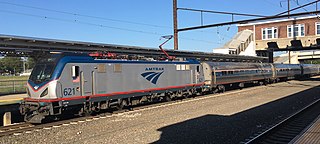
The Keystone Service is a 195 mile regional passenger train service from Amtrak between the Harrisburg Transportation Center in Harrisburg, Pennsylvania, and 30th Street Station in Philadelphia, running along the Philadelphia to Harrisburg Main Line. Most trains continue along the Northeast Corridor (NEC) to Penn Station in New York City.

MARC is a commuter rail system in the Washington–Baltimore area. MARC is administered by the Maryland Transit Administration (MTA) and operated under contract by Alstom and Amtrak on track owned by CSX Transportation (CSXT) and Amtrak. In 2022, the system had a ridership of 2,815,900, or about 12,500 per weekday as of the second quarter of 2023, less than pre-COVID-19 pandemic weekday ridership of 40,000.

The Northeast Corridor Line is a commuter rail service operated by NJ Transit between the Trenton Transit Center and New York Penn Station on Amtrak's Northeast Corridor in the United States. The service is the successor to Pennsylvania Railroad commuter trains between Trenton and New York, and is NJ Transit's busiest commuter rail service. After arrival at New York Penn Station, some trains load passengers and return to New Jersey, while others continue east to Sunnyside Yard for storage. Most servicing is done at the Morrisville Yard, at the west end of the line. The Northeast Corridor Line is colored red on NJ Transit system maps and its symbol is the State House. The Princeton Branch is a shuttle service connecting to the line. Connecting SEPTA Trenton Line service between Philadelphia and Trenton is listed in the timetable.

Suburban Station is an art deco office building and underground commuter rail station in Penn Center in Philadelphia. Its official SEPTA address is 16th Street and JFK Boulevard. The station is owned and operated by SEPTA and is one of the three core Center City stations on the SEPTA Regional Rail and one of the busiest stations in the Regional Rail System.

Amfleet is a fleet of single-level intercity railroad passenger cars built by the Budd Company for American company Amtrak in the late 1970s and early 1980s. Budd based the Amfleet design on its earlier Metroliner electric multiple unit. An initial order for 57 cars in 1973 to supplement the Metroliners on the Northeast Corridor grew to two orders totaling 642 cars, sufficient to reequip all the services on the Northeast Corridor and many other routes around the United States. The first 492 cars, known as Amfleet I and completed between 1975 and 1977, were designed for short-distance service. A second order of 150 cars, known as Amfleet II and completed between 1980 and 1983, were designed for long-distance service. They were the last intercity passenger cars built by Budd.

Rahway station is an NJ Transit train station in Rahway, New Jersey that is located 20.7 miles southwest of New York Penn Station, with service on the Northeast Corridor and North Jersey Coast lines.
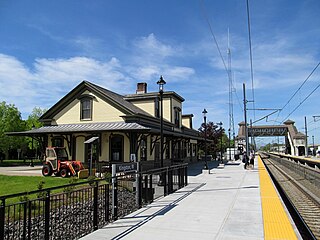
Kingston is a historic railroad station located on the Northeast Corridor in the village of West Kingston, in the town of South Kingstown, Rhode Island. It was built at this location in 1875 by the New York, Providence and Boston Railroad, replacing earlier stations dating back to the opening of the line in 1837. Current rail services consist of Northeast Regional trains in each direction, most of which stop at the station. Historically Kingston provided commuter rail service to Providence and Boston via Amtrak's commuter rail services. The MBTA is looking at extending their commuter service on the Providence/Stoughton Line.

Clinton station is a regional rail station served by the CTrail Shore Line East service located near downtown Clinton, Connecticut. The station has two side platforms connected by a footbridge. Clinton is a commuter-only station; Amtrak's Acela Express and Northeast Regional services run through the station without stopping.
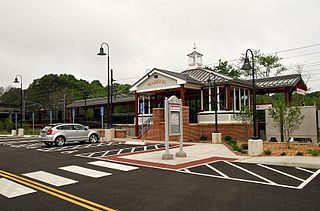
Madison is a passenger rail station along CTrail's Shore Line East commuter rail line, which runs on the Northeast Corridor between New Haven and New London. Madison station consists of a mid-sized parking lot and one high-level side platform on the southbound side of the tracks.
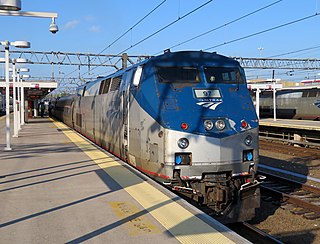
The Hartford Line is a train service run by Amtrak primarily between Springfield, Massachusetts, and New Haven, Connecticut, along Amtrak's New Haven–Springfield Line.
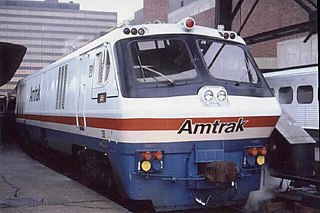
The Beacon Hill was a daily 157-mile (253 km) commuter rail service operated by Amtrak between Boston, Massachusetts, and New Haven, Connecticut, from 1978 to 1981. The Beacon Hill was one of the last long-haul commuter services operated by Amtrak. Service consisted of a single rush-hour round trip, with service eastbound to Boston in the morning and westbound to New Haven in the evening.

The Bowie Railroad Buildings comprise three small frame structures at the former Bowie train station, located at the junction of what is now the Northeast Corridor and the Pope's Creek Subdivision in the town center of Bowie, Maryland. The complex includes a single-story freight depot, a two-story interlocking tower, and an open passenger shed. The station was served by passenger trains from 1872 until 1989, when it was replaced by Bowie State station nearby. The buildings were restored in 1992 as the Bowie Railroad Museum and added to the National Register of Historic Places in 1998.

The Budd Metroliner was a class of American electric multiple unit (EMU) railcar designed for first-class, high-speed service between New York City and Washington, D.C., on the Northeast Corridor. They were designed for operation up to 150 miles per hour (240 km/h): what would have been the first high speed rail service in the Western Hemisphere. Although 164 mph (264 km/h) was reached during test runs, track conditions and electrical issues limited top speeds to 120 mph (190 km/h) in revenue service. The single-ended units were designed to be arranged in two-car sets, which were in turn coupled into four to eight-car trains.

The Chesapeake was a daily passenger train operated by Amtrak along the Northeast Corridor between Washington, D.C., and Philadelphia, Pennsylvania, from 1978 to 1983. It was one of the few commuter trains operated by Amtrak.
The Clamdigger was a daily passenger train which ran along the Northeast Corridor during the 1970s. The train had two iterations: from 1898 to 1972 it was a local commuter service under the New Haven Railroad, Penn Central, and Amtrak between New London and New Haven, while from 1976 to 1978 it was a long-distance commuter service operated by Amtrak from Providence to New Haven. In 1978, it was canceled and replaced with the Beacon Hill.

Niantic was a train station on the Northeast Corridor located in the Niantic village of East Lyme, Connecticut. Opened in the 1850s, it was rebuilt in 1899 and again in 1954 by the New Haven Railroad. It closed in 1972, then reopened from 1978 to 1981 for use by the Amtrak Beacon Hill. A new station has since been proposed to be built in Niantic to serve the Shore Line East commuter rail service.
Lanham station was a regional rail station on the Northeast Corridor, located just outside the Capital Beltway off Route 450 in Lanham, Maryland. It was served by the predecessor of today's MARC Penn Line, until August 1982.




















